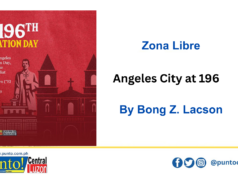Since that time, Pampanga has evolved into a modern province hosting the country’s next premiere international gateway – the Clark International Airport (CIA).
Already, the Clark Freeport Zone (CFZ) on its northwestern section has been a magnet of foreign investors currently employing more than a hundred thousand and more in the next few years.
Home of Presidents Today, Pampanga is known as the home of Presidents.
Beginning with the country’s ninth president Diosdado “Cong Dadong” Pangan Macapagal, the province was a fountain of human resources. A native of Lubao, Macapagal’s legacy of Land Reform saw the start of the emancipation of farmers from the bondage of the soil.
The Poor Boy from Lubao was followed by Corazon “Cory” Cojuangco- Aquino, the first elected woman president not only in the Philippines but in Asia as well. Aquino, then a plain housewife, was catapulted to the presidency by the world renowned People Power Revolution in 1986.
She hails from Paniqui in Tarlac province which in ancient times was part of the Kapampangan region. In 1998, the first female Vice President was elected in Gloria Macapagal- Arroyo, daughter of President Macapagal. Three years later, Arroyo assumed the presidency from the ousted President Joseph Estrada and was elected president in 2004 as the country’s 14th president.
In 2010, incumbent President Benigno Simeon “Noynoy” C. Aquino III was elected as the 15th president of the Philippines under the Liberal Party. He was the son of President Cory Aquino and martyred national hero Benigno “Ninoy” Aquino Jr. who hails from Concepcion, Tarlac.
Rising from the ashes
Pampanga was well on its way to becoming a modern province until the eruption of Mt. Pinatubo in June 1991 and its subsequent lahar events that totally buried communities and villages causing major devastation to the province. But true to form, the Kapampangans’ resiliency came to fore as Pampanga slowly rose from the ashes.
Then-Governor Bren Z. Guiao rallied the Kapampangans not to lose hope with his famous quote: “Eko magmalun, mibangun ya ing Pampanga (Don’t worry, Pampanga will rise again).”
At present, Pampanga is fast developing as an alternative modern metropolis from the heavily congested Metro Manila which is located some 80 kilometers to the south.
With the presence of the CFZ, Pampanga is now a beehive of economic activities contributing substantially to the Gross Domestic Product. The province’s wide open spaces (total land mass of 206,247 hectares) is suitable for further development especially with its relatively flat terrain with only one distinct mountain, the majestic Mount Arayat which has become a symbol of the province.
Nanay Baby
Under the helm of incumbent Gov. Lilia G. Pineda, Pampanga has made leaps and bounds with its sand quarrying revenue collection totaling more than P1.5 billion so far with a target of P2 billion total collections next year.
Sand, ejected by Mt. Pinatubo during its violent eruptions, has turned into abundant blessings for the province.
But Gov. Pineda or more fondly and popularly called Nanay Baby was compassionate for the sick making health services as the priority in her administration with its sustainable delivery by constructing hospitals or improving them and equipping them with modern and state-of-the-art medical equipment and facilities as well as ample and professional human resources.
Pineda’s governance is guided by her 12-point agenda of Good Governance, Poverty Alleviation, Social Amelioration, Equal Access to Quality Education, Environmental Sustainability and Disaster Resiliency, Attractive Investment Climate, Adequate Infrastructure Support, Peace and Order and Public Safety, Conservation and Promotion of Kapampangan Culture, Arts and Heritage, Tourism Promotion, Promotion of Private-Public Partnership, and Sustainable Quality Health Services.
She remains as the “mother” of all Kapampangans with her genuine maternal affection which has discouraged anyone to run against her in the next elections.
Notable Kapampangans
Some of the most notable Kapampangans living today are leaders in business like tycoon Manuel V. Pangilinan, chairman of PLDT among other companies; Bangko Sentral ng Pilipinas Governor Amando M. Tetangco, Jr.; real estate developer and former Senator Manny B. Villar, Jr. whose Kapampangan mother Curita “Curing” Bamba hails from Orani, Bataan, a province which was once part of the Kapampangan region; Ruperto Cruz, a noted furniture maker and owner of the Grand Palazzo Royale as well as the Royal Garden Golf and Country Club and chair of the advocacy group Pinoy Gumising Ka Movement; Liberato P. Laus, chairman and CEO of the Laus Group of Companies; Prudencio Garcia, president of Mekeni Foods Corp.; Lolita O. Hizon, owner of Pampanga’s Best; and popular businessman, sportsman and kingmaker Rodolfo Q. Pineda, Pampanga’s First Gentleman.
There are also Kapampangans who excel in sports giving the Philippines a mark in international competitions among them billiards king Efren “Bata” Reyes and Francisco “Dyango” Bustamante.
Some of the standouts in Arts and Culture include Andy Alviz a noted international director, songwriter and artist; internationally renowned ecclesiastical sculptor Willie Layug; filmmaker Brilliante Mendoza; and celebrity singers Lea Salonga, Allan Pineda (Apple de. Ap of the three-time Grammy awardee Black Eyed Peas), Arnel Pineda (lead singer of the famous band Journey), Bamboo Manalac and Mon David among others.
Kapampangan cuisine
Not to be left out is the Kapampangan cuisine or “Lutung Kapampangan” in the Pampango dialect which brought forth the famous sisig, morcon, menudo, caldereta, estofado, embotido, asado, lengua, lechon, chicharon, afritada, bringhi (paella), tabang talangka (crab meat), bulanglang or pork soup made from guava juice, tocino or “pindang”and the native longaniza. The Kapampangans flair for exotic foods is also well-known like the betuteng tugak or stuffed frog, adobong camaru or sautéed mole crickets, calderetang barag or spicy monitor lizard stew, kubang asu or spicy dog stew, and tidtad or blood stew.
Tourists’ attractions
Tourism is a growing industry in the province of Pampanga with the development of the CIA.
The most famous tourist attraction in Pampanga is the annual crucifixion where penitents or flagellants depict the passion of Christ on Good Friday by being nailed to the cross.
Thousands of local and foreign tourists flock to Barangay San Pedro Cutud in the City of San Fernando and Barangay Lourdes North West in Angeles City to witness the crucifixions.
Penitents considered these acts to be mortification of the flesh and undertake these to ask forgiveness for sins, to fulfil a panatà or vow or even to express gratitude for favors granted.
Predominantly Roman Catholics, Pampanga has some of the most beautiful churches in the Philippines including the St. James the Apostle Parish Church in Betis, Holy Rosary Parish in Angeles City, San Agustin Church in Lubao and the Santa Monica Parish Church in Minalin.
Some of the museums include the Clark Museum, the Museo Ning Angeles, the Kapampangan Center at the Holy Angel University and the Philippines only Museum of Social History also located in Angeles City.
Giant lanterns
During the Christmas season, Pampanga becomes the core of a thriving industry centered on handcrafted lighted lanterns called “parols” that display a kaleidoscope of lights and colors.
The Ligligan Parul or Giant Lantern Festival, which draws thousands of spectators, is held in an annual competition of the best giant lantern from among the participating barangays in the City of San Fernando.
Geography
Information culled from the internet described Pampanga as “a province of the Philippines located in the Central Luzon region. Its capital is the City of San Fernando. It is bordered by the provinces of Bataan and Zambales to the west, Tarlac and Nueva Ecija to the north, and Bulacan to the southeast.
Pampanga also lies on the northern shore of Manila Bay. Angeles City, although within the geography of Pampanga, is classified as a firstclass, highly urbanized city and has a government independent of Pampanga.
The name La Pampanga was given by the Spaniards who found the early natives living near the river banks. The town of Bacolor in the province served as the capital of the archipelago for two years from 1762-1764 during the British invasion of Manila.
The word pampang, from which the province’s name originates, means river bank. Its creation in 1571 makes it the first Spanish province in the Philippines.”
Pampanga Day activities
To celebrate Pampanga Day, a series of activities were lined-up starting on Dec. 7 where a Holy Mass was held to start the festivities followed by a civic military parade at Capitol grounds.
Among them the book launching of Sapni ng Crissot “Alang Dios,” Aldo ding Purok Leaders; Local Officials Banquet at Pradera Verde Lubao; the Year end Assessment of Barangay Tanods at the Lubao Gym and Aldo Ding Barangay Officials and Rice Planters Day. A Zumba (inter town) competition was held on Dec. 8 and later a Holy Mass was held at the Executive House to celebrate the Feast of the Immaculate Concepcion.
On Dec. 9, the Aldo Ding Barangay Health Workers was held and on Dec .10, the highly anticipated Mutya Ning Kapampangan Coronation night was held at the Bren Z. Guiao Convention Center.
To cap the celebration, the Most Outstanding Kapampangan Awards (MOKA) will be held at the Holiday Inn Clark on Dec. 11 to honor the best Kapampangans that gave remarkable distinction to the province with their personal endeavors.




